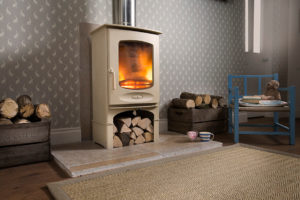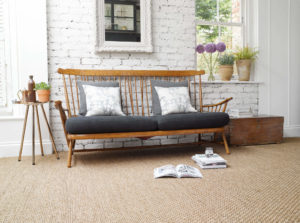Eco-friendly flooring can be stylish and sustainable
Eco-friendly flooring can be stylish and sustainable
Is it time you went green from the ground up?
There is a growing market in eco-friendly flooring with more choice than even before - so you can go green without sacrificing on style. Here we look at a few of the main eco options.

Image supplied by Sisal & Seagrass
What is eco flooring?
Sustainability is a key consideration. Do the materials come from a renewable source or one that is depleting? For example, a 100% wool carpet is sustainable as sheep regrow their woolly coats every year, so it is a resource that is easily replaced. Truly eco-friendly flooring is made without toxic chemicals that harm the environment or release Volatile Organic Chemicals (VOCs) into your home.
Other factors to consider include level of waste in the production process, how far the flooring material will travel to your home (floor miles) and if it can be recycled or is biodegradable.
Durability is important, too. Invest in a robust flooring and it may last for decades, so fewer materials, energy and chemicals will be used to make replacements, cutting your carbon footprint.
Sustainable timber flooring
Wood doesn’t need to be reclaimed to be planet-friendly, but it does need to come from well-managed and sustainable forests. Flooring timbers are still sourced from deforested areas and ever-depleting rainforests. Deforestation is a major problem with only 18% of forests protected worldwide, according to a 2020 report by the United Nations Food and Agriculture Organization (FAO).
Usually, the more exotic the tree species, the less sustainable it is likely to be. This means that commonly grown oak, pine and maple are greener options. Choose a supplier that sources timber from responsibly managed forests carrying the FSC logo, such as the Solid Wood Flooring Company. This company is also PEFC certified. This means that all certified flooring can be traced back to the responsibly managed forest where it was harvested.

Image supplied by The Solid Wood Flooring Company
Ethical hardwood floors are more durable than carpets or laminates. If you want to be truly green, carefully consider your choice of varnishes, oils and adhesives. As hardwood can absorb water, it isn’t a practical choice for bathrooms or other high-moisture areas.
Linoleum flooring
The 1960s have a lot to answer for when it comes to home décor. Think macrame wall hangings, swirly pattern wallpaper and perhaps most memorable of all linoleum flooring. But lino is making a comeback. Made from all-natural, easily renewable resources, including cork powder and linseed oil, it is one of the greenest flooring options available. It doesn’t emit VOCs and has natural antibacterial qualities, so no need for harsh chemical cleaners.
Natural linoleum - as distinct from synthetic versions or vinyl - can last for many years and at the end of its life cycle, can be recycled to create new sheets of the flooring material. The natural surface texture of lino is grainy matte finish, but it can be buffed to a polished sheen to give rich deep colours. There’s a wide variety of hues and patterns to choose from.
Cork
Like natural linoleum, cork flooring has been around for decades and is undergoing something of a revival because of its eco credentials. Made from the bark of the cork oak tree which grows back after being harvested, it is a completely natural and easily replenishable material. The first harvest takes place when the tree is about 25 years old and then every seven to 14 years. The trees, which grow mainly in the Mediterranean, can continue to produce cork for 150 years or more.
Sustainably grown and harvested cork is biodegradable and recyclable; Cork flooring can even be made from bottle corks. Cork has many desirable qualities as a flooring material, including acting as a natural sound and thermal insulator. Soft underfoot and water-resistant, cork can be a good choice for damp bathrooms and kitchens. Excessive water or flooding will, however, cause the cork to warp and lift like most wooden floors.
Natural fibre woven floor coverings
Woven natural fibres such as coir, jute, seagrass, sisal and wool are all sustainable flooring options that don’t release VOCs into your room unlike some synthetic carpets. Made from natural fibres, the textures vary from rough coir to soft wool. Carpets made from natural materials require less energy and chemicals to produce and can be recycled or are biodegradable.
Hard wearing natural fibre flooring can be perfect for high traffic area like stairs and hallways. Sisal is especially popular as it’s affordable and can be spun into a range of weaves and styles. Some wool carpets are mixed with small amounts of polyester to increase lifespan. Be aware wool carpets are vulnerable to moth attack if they aren’t chemically treated. A moth-eaten carpet isn’t a good look and it can be costly to replace, too.

Image supplied by Sisal & Seagrass
Reclaimed flooring
Reclaimed tiles and wooden floorboards are the epitome of eco-chic. They add a unique character to your home. Sources include reclamation yards and specialist suppliers who clean them up ready to be re-loved. While tiles need to be fired at high temperatures, making manufacturing an energy-intensive process, if the materials are salvaged, they don’t go to waste and can be reused. Fired Earth, for example, stocks a range of reclaimed terracotta tiles from Europe in rich reds to deep ochres.
Solid wood floorboards and parquet floors may be reclaimed when buildings are demolished or refurbished. Salvaged flooring may include rarer timber species which are less sustainable if bought new. Be aware lack of uniformity of reclaimed boards can make fitting lengthier and costlier. There are specialist suppliers, such as Haywoods, that saw, sand and profile reclaimed wood flooring, so it’s more easily installed in your home.
When searching for reclaimed flooring materials, look for suppliers who abide by the Salvo code. This is best practice for ethical sourcing of architectural salvage.
Solid stone floors
When it comes to choosing an eco-friendly type of stone flooring for your home, look for UK sources. Flooring made from local natural stone is a low carbon material compared with other construction materials, including vinyl, laminates and hardwood flooring, according to a study by SISTech, working with Herriot-Watt University. Researchers looked at the processing of stone, transport to site and volume of waste products. The biggest stone exporting countries include Spain, Poland, India, China and Scotland. So, opt for local stone to reduce your carbon footprint.
Biobased flooring
Engineered mushroom flooring is among the more innovative sustainable options now available. The company Mogu produces floor tiles with fungal mycelium, the vegetative part of mushrooms. The technology involves growing selected strains of mycelium on a variety of nutrient-rich, organic waste fibres from industries such as agriculture and textiles. The mycelium acts as a reinforcement to the matrix structure, creating a 100% plastic free, composite material. The resulting floor tiles are not only beautiful and natural, says Mogu, but can resist heels, scratches and abrasions just like any conventional floor. The products have been tested for allergenic and VOC emissions and are safer than wood and many other industrial materials inside our homes, says the manufacturer.
When comparing eco-flooring, make sure to factor in sustainability, durability, waste, travel miles and recyclability. There are lots of green and attractive options if you shop around.
